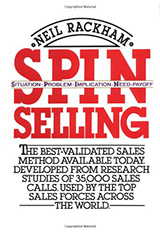My Notes on “SPIN Selling” by Neil Rackham:
The difference between small and large sales
- Define Small Sale: Is a sale which can normally be completed in a single call and which involves a low dollar value.
- In selling consumer goods product knowledge makes all the difference. But in large sales it can prevent success because the customer won’t see enough value to justify so large a decision.
- Customer hesitation when deciding about a large sales isn’t so much about the product as entering a relationship. You will have to work with the seller over a period of some months rather than just buy the item and walk out the door.
- In small sales the customer can afford to take more risks because the consequences of mistakes are relatively small.
The SPIN sequence of questions
- Situation Questions.
- Don’t overuse them and bore the customer.
- Who do they benefit? The seller. “Tell me about your business”, or “What steps do you go through in making a purchasing decision here?”
- Do your homework before the call.
- Problem Questions. Explore problems, difficulties and dissatisfaction.
- Implication Questions.
- Ask how the problems will affect future profitability, customer satisfaction etc.
- The idea is to take a problem that the buyer perceives to be small and build it up into a problem large enough to justify action and build up the value or usefulness of the solution
- Decision makers seem to respond most favourably to salespeople who uncover implications
- Implication questions are sad
- Need-payoff Questions.
- If you ask the buyer to explain to you which elements of the problem your solution can solve, they are explaining the payoff themselves, and will find the solution more acceptable
- “Is it important to you to solve this problem?
- “Why would you find this solution so useful?”
- “Is there any other way this could help you?”
- The buyer’s attention is now focused on how the solution would help, not on product details. It is easier for them to remember this when convincing others rather than a list of features.
- Need-payoff questions are happy
How to prepare Implication Questions
- Write down a potential problem the customer is likely to have
- Then ask yourself what related difficulties this problem might lead to, write these down.
- For each difficulty, write down the questions it suggests
Avoid need-payoff questions too early in the call
- The will likely put the customer on the defensive. Build up needs before asking need-payoff questions such as “If I could show you a way to increase productivity here, would you be interested?” “Would you be interested in a faster way to process your accounts?”.
- Better: “why is that important?”, “how would that help?”, “would it be useful if…”, “is there any other way this could help you?”
Use open or closed questions?
- Using open or closed questions is less important than addressing all the SPIN areas above
Handling objections
- Successful sellers concentrate on objection prevention, not on objection handling.
Closing
- Define Closing: A behaviour used by the seller which implies or invites a commitment, so that the buyer’s next statement accepts or denies commitment.
- Closing technique work when the sale is small, but fail to work as the size of the sale increases
- Closing techniques speed sales, but in larger sales you want more time with the client, not less. You don’t wonder “How can I cut down on the time I’m spending with the key decision makers?”
- Your objective shouldn’t be to close the sale, but to open a relationship
Plan for the 4 outcomes of a sales call
What is your objective for your call? Know before you call if you want an order, or advance.
- Order
- Advance
- Moves the sale forward toward a decision. If this isn’t your goal for the call you are wasting your prospects and your time
- Continuation
- Customers often make positive noises at the end of a call as a polite way to get rid of an unwanted seller. This is not an action. An advance is successful, this is a “continuation” which is not.
- No-sale
Define Need: Any statement made by the buyer which expresses a want or concern that can be satisfied by the seller
Define Value: When the customer perceives the problem to be larger than the cost of solving it
Cost isn’t the only consideration for the buyer
- In major sales, you must develop the need further so that it becomes larger, more serious and more acute in order to justify the additional cost of your solution. Remember that in larger sales the cost isn’t measured only in terms of money. A bad decision can cost the buyer his job. The buyer often perceives significant risks and hassles which add to the cost side of the value equation.
How listing all the features can backfire for low priced products
- For lower-priced products, by listing all the features the customer comes to expect a higher price. When the product turns out to be much cheaper than its competition, the increased price sensitivity cause the buyer to fell extra positive about the lower price tag. But if the item is 100 times as expensive, the price concern created by features will make people less likely to buy. (That’s why really expensive watches have very few features, and emphasise their style instead!)
